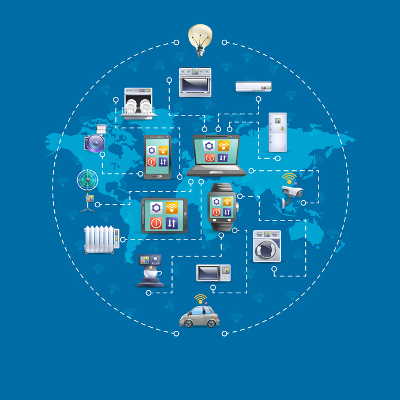More and more devices now connect to the internet than ever before. This is the Internet of Things. They can be convenient, entertaining and useful, but such devices are a well-documented potential security threat. People may drop their guard if they have a seemingly harmless, internet-connected kettle, which somehow doesn’t seem to be as much at risk as a laptop or a smartphone. This is a misconception. Any one of your connected devices could be a weak link in your computer security. October is Cyber Security Month around the world, so let’s take a look at some of the dangers and how to protect yourself.
One reason that businesses buy into the Internet of Things is to increase efficiency. But it can come at a cost. It’s not just businesses that are potentially at risk either. Most of us probably have at least one Internet of Things device. These are some of the things in question: internet-connected houses, thermostats, cars, fitness trackers, baby monitors, home security cameras, smart watches, kettles and other household appliances. It’s not just theoretical that hackers can gain access to these devices and cause problems.
The Internet of Things is defined as follows by the Internet Crime Complaint Center (IC3): ‘IoT devices connect through computer networks to exchange data with the operator, businesses, manufacturers, and other connected devices, mainly without requiring human interaction’.
In other words, these devices just do what they do, and users use them without giving them a second thought. But there’s a problem: whose responsibility is it to ensure that they are secure? The manufacturer or the user? The IC3 suggests that users need to make sure they’re not exposing themselves to cybercrime. But there’s a counter-argument too. ZDNet suggest that this isn’t realistic, and most people are either oblivious to or dismissive of the potential for cybercrime, until things have actually gone wrong. The importance of cybersecurity is still not properly appreciated by many.
What about the makers and sellers of IoT devices? Shouldn’t they carry some responsibility here? They surely know that their clients aren’t security professionals who understand the risks, or can even recognize that there’s a problem, unless they’re warned about it. Of course, that’s not really happening. That’s why managed services providers like Quikteks have taken on this responsibility. We are committed to assisting the New Jersey community to implement best practices when it comes to security.
There are still a number of steps you can take yourself to make sure that your Internet of Things devices aren’t a security problem. Here are some guidelines:
Do your research. Check out the manufacturers’ reputations and only buy IoT devices from those who’ve got a good track record with security.
Make sure you understand how Internet of Things devices communicate with each other, so you know where gaps in your security might be.
Most devices require passwords, or are associated with accounts that require passwords. Make sure that you don’t just use the default password that comes with the device. Change it to a strong one with letters, numbers and symbols, and remember to keep changing it over time.
Internet of Things devices have many advantages but you should always weigh the risks, as well as reaping the rewards. Quikteks would like to help, with information and advice on how Internet of Things devices work and how to protect against cybercrime and security threats. To make sure your business network is secured against potential IoT threats, call us at (973) 882-4644 for assistance.

